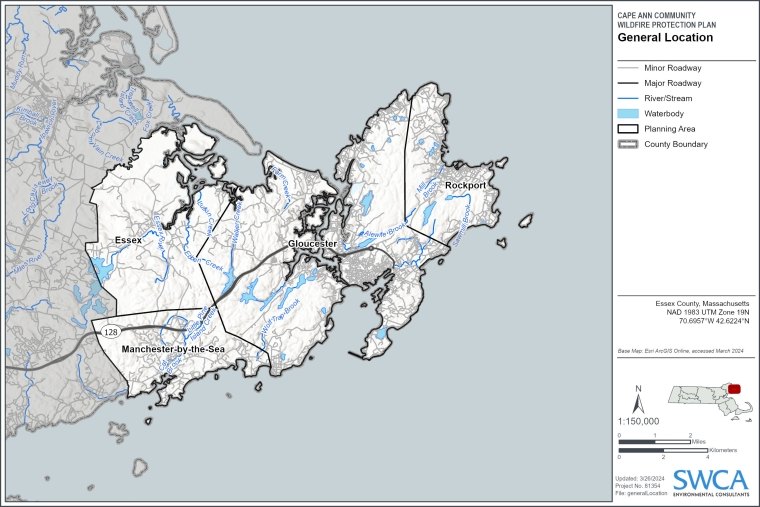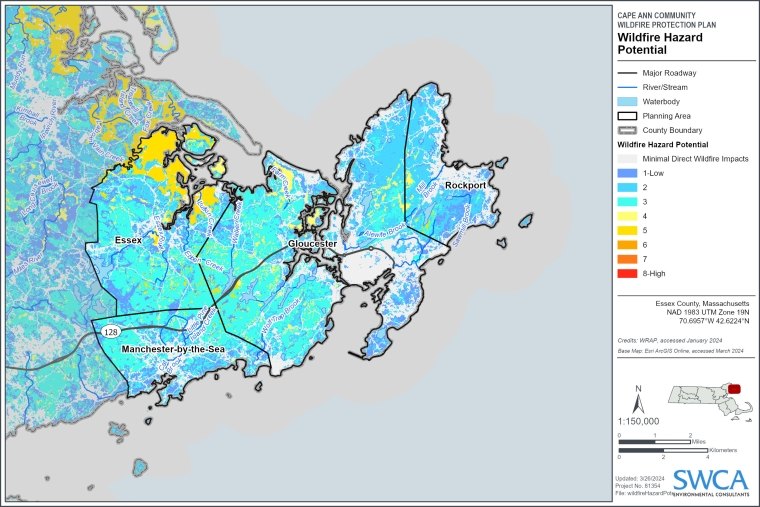The community of Cape Ann, Massachusetts, will now be able to better prepare for, reduce the risk of, and adapt to wildfire with its first Community Wildfire Protection Plan (CWPP) developed by SWCA.
RECURRING DROUGHT CONDITIONS RAISES WILDFIRE RISK, EVEN ON THE NORTHEASTERN US COAST
Home to some of the oldest seaports in the United States, Cape Ann has an enduring community and attracts more than twice its population in annual visitors. With its quaint harbors, fresh seafood, and salty air, wildfire doesn’t initially appear to be a risk.
Yet, wildfires have remained present across the Cape Ann peninsula in northeastern Massachusetts, comprised of the towns of Gloucester, Rockport, Essex, and Manchester-by-the-Sea. Among the significant incidents in recent history were the Poles Hill Fire in August of 2022 and the Quarry Fire in April of 2023, both of which garnered national attention due to their impact on the region.
The severity of Cape Ann’s recent wildfire incidents and recurring drought conditions raise legitimate concerns about the risk that lies ahead. While community members have not experienced frequent, extensive, or high-severity fires, local fire managers understand that a large fire in the region is possible, and that, without a comprehensive plan to manage these factors, fire risk is increasing.
The Gloucester Fire Department recognized the need for more proactive wildfire planning. And a plan that encompassed the desires of the community, evaluated fire risk, and defined clear and actionable wildfire mitigation and preparedness guidance based on scientifically sound methods — a plan designed to create a safer place.
With the goal to address the hazards and risks of wildland fire throughout Cape Ann, the Gloucester Fire Department turned to SWCA to develop the community’s first-ever Community Wildfire Protection Plan.
 Planning area for the Cape Ann Community Wildfire Protection Plan.
Planning area for the Cape Ann Community Wildfire Protection Plan.
INTEGRATING LOCAL PERSPECTIVES AND EXPERT ANALYSIS TO MITIGATE WILDFIRE RISK IN CAPE ANN
Collaboration and communication are key to an effective CWPP. SWCA wildfire experts first brought together a group of representatives — fire chiefs, planning board members, department of public works employees, leaders from local and regional community planning nonprofits, etc. — from multi-jurisdictional agencies (state and local) and regional and municipal organizations of Cape Ann to make sure the plan is tailored to the local concerns and conditions.
To build the foundation of Cape Ann’s CWPP, SWCA wildfire experts worked with national and statewide fire modeling datasets to curate wildfire hazard and risk across the planning area. SWCA compiled and analyzed a large amount of background information on Cape Ann, including location and land use data, climate and weather data, baseline vegetation data, historic conditions, population and demographics, fire regime and baseline conditions, fire policy, and other supporting background information. The team also integrated data from field assessments to document community scale conditions.
Once completed, Cape Ann’s wildfire risk assessment served as the framework to:
- Enable land use managers, fire officials, planners, and others to prepare strategies and methods for reducing the threat of wildfire.
- Begin collaborating with community members through outreach and education regarding methods for wildfire mitigation, reducing the unwanted impacts from wildfire.
- Identify and prioritize fuel treatments based on where wildfire risk is greatest, with options for both public and private land.
In contrast to the vast, wildfire-prone landscapes of the West, Cape Ann’s unique wildfire mitigation challenges stem from its dense development, its historic and cultural landmarks, and a mosaic landscape with a patchwork of vegetation types (coastal lowlands and cliffs blend into forests and woodlands).
“Fortunately, we already had experience working with East Coast communities on wildfire mitigation projects and could leverage our insights from developing CWPPs for Long Island, New York, and Martha’s Vineyard, Massachusetts,” said Vicky Amato, principal planner of fire and forestry at SWCA.
“Coming from a background of working on CWPPs in the West, there are certainly unique elements to wildfire planning for an East Coast community like Cape Ann. For one, wildfire isn’t as prominent a topic here, so we focused heavily on educating and communicating the importance of this effort to engage residents,” said Arianna Porter, wildfire ecologist at SWCA and project manager for Cape Ann’s CWPP.
“Additionally, the area’s infrastructure, with its narrow and winding roads dating back to the late 1600s, required us to include specific recommendations to facilitate fire truck access and improve evacuation routes. Another critical aspect is the region’s dense invasive vegetation growth that has altered landscapes, shifting the character of understory vegetation in many areas to be more fire prone. Addressing these unique challenges has been essential in crafting a comprehensive and effective wildfire protection plan for Cape Ann.”
Within the CWPP, SWCA wildfire experts provided comprehensive recommendations with respect to the three primary goals of the National Cohesive Wildland Fire Management Strategy:
1) restore and maintain resilient landscapes
2) create fire-adapted communities
3) improve wildfire response
For example, in addition to implementing mechanical fuel treatments to decrease the likelihood and severity of wildfires, Cape Ann fire departments and local governments are recommended to partner with transportation agencies to reduce fuel loads adjacent to key roadways and improve critical transportation routes to facilitate rapid and safe evacuation and emergency response. Cape Ann’s CWPP also includes recommendations for homeowners, landowners, and residents, like more information on smoke detection and reporting, creating defensible space, and evacuation planning.
CAPE ANN’S CWPP BUILDS COMMUNITY RESILIENCE AND BRINGS WILDFIRE MITIGATION PLANNING TO ACTION
Creating Cape Ann’s Community Wildfire Protection Plan is only the start of what it looks like to work together across jurisdictions to become a more fire-adapted community that’s resilient to wildfires.
With a comprehensive plan in hand, complete with defensible data and prioritized wildfire mitigation strategies, the community of Cape Ann can now move forward on obtaining funding, implementing mitigation and educational programs, and continuing to expand the conversation of wildfire with residents.
“The entire [SWCA] team was awesome to work with. [They are] knowledgeable professionals that kept the project moving forward on time and delivered more services than expected and all on budget,” said Eric Smith, fire chief at Gloucester Fire Department.
Learn more about wildfire planning services at SWCA.
 A map showing the modeled wildfire hazard on an 8-point, low-to-high scale for the planning area as a part of Cape Ann’s CWPP.
A map showing the modeled wildfire hazard on an 8-point, low-to-high scale for the planning area as a part of Cape Ann’s CWPP. 